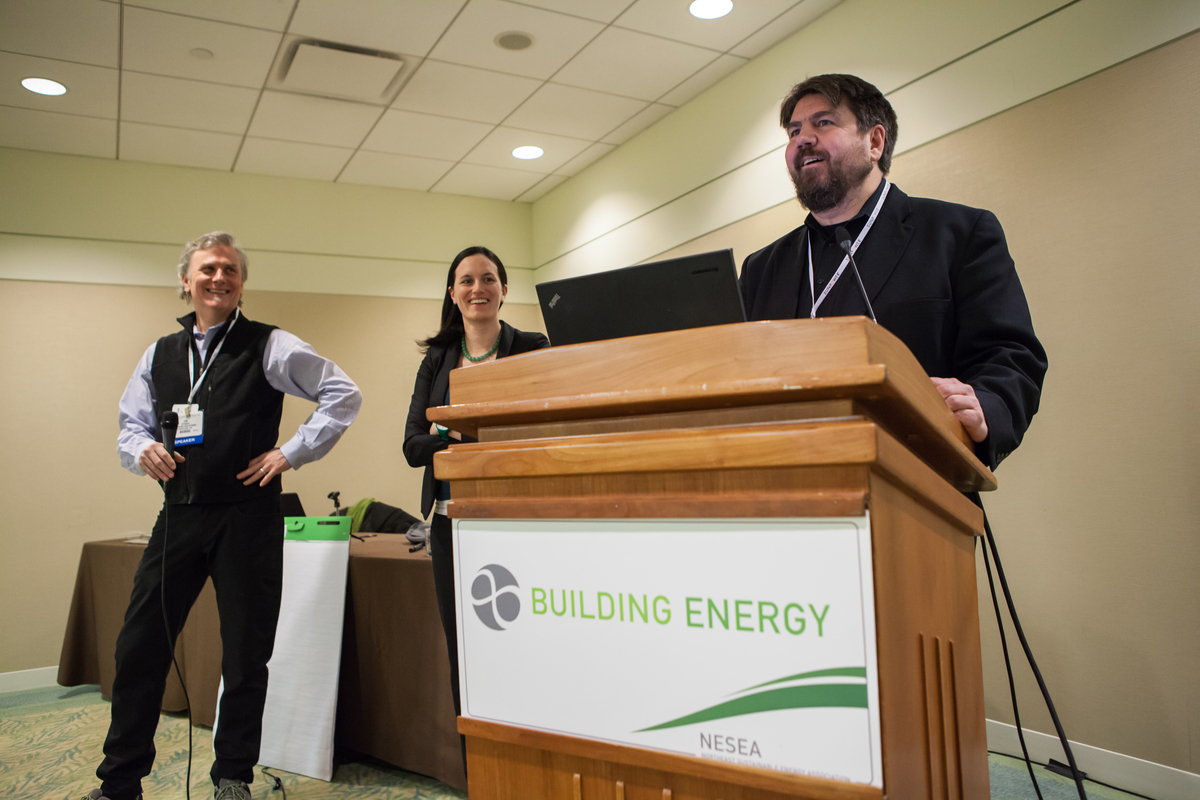
Energy Efficiency and Green Building Technologies - Made in Germany
Cooperation is likely to take place between Germany and the United States before the upcoming United Nations Climate Change Conference, said Helmut Landes, deputy consul general of the Consulate General of the Federal Republic of Germany.
Landes spoke at BuildingEnergy 15 in Boston on March 3 at a session titled “Energy Efficiency and Green Building Technologies - Made in Germany.”
“Germany has become avant garde in energy-saving,” Landes said. “Energy efficiency has become a household term.”
German companies in the United States are forging ahead with new technologies for sustainable construction and energy efficiency.
For example, Kurt Roth, director of building energy technologies at Fraunhofer Center for Sustainable Energy Systems, says his laboratory expects to file a patent for a new analytical technique to predict which utility customers are likely to participate in energy efficiency programs.
“The challenge a lot of energy efficiency programs face today is that they market to everyone, so they have high customer acquisition costs,” Roth said.
 Roth said utilities have tried to analyze who is likely to sign up for efficiency programs, but “segmentation has a very low predictive power.”
Roth said utilities have tried to analyze who is likely to sign up for efficiency programs, but “segmentation has a very low predictive power.”
To crack the code, Fraunhofer has taken a big-data approach. The laboratory does not use any demographic or energy use data other than information from smart meters.
The model has produced impressive results. Using data from one West Coast utility, Fraunhofer is now predicting which customers will sign up for efficiency programs with an accuracy of 90.5-92.4 percent.
Additionally, Fraunhofer has been experimenting with vacuum insulation panels (VIPs). A test installation on a commercial building in Maine yielded a total reduction in space heating energy consumption of 48 percent. 41 percent of the drop was attributed to the panels themselves.
The Arrival of LEED v4: Everything You Need to Know to Succeed
When you get down to the gritty details of constructing a green building, surprises can occur. According to “The Arrival of LEED v4: Everything You Need to Know to Succeed,” a panel on March 3 at BuildingEnergy 15, LEED now requires envelope commissioning. This can result in unexpected discoveries.
“We have been able to uncover flaws,” said Andrea Love, director of building science at Payette Associates. She showed an infrared image of a building with thermal bridging issues in its walls.
“You can’t be at NESEA unless you show an infrared image,” quipped Chris Schaffner, principal and founder at The Green Engineer.
 Love explained the source of these problems is incorrect design – putting too many metal parts through walls. “Architects and designers don’t understand enough about thermal performance,” she said. “We just need to design things better.”
Love explained the source of these problems is incorrect design – putting too many metal parts through walls. “Architects and designers don’t understand enough about thermal performance,” she said. “We just need to design things better.”
“We don’t often think about heat flows in three dimensions either,” Schaffner said,
Schaffner said an architect told him once that since a thermal bridge only took up 2-3 percent of a wall, it was inconsequential.
“Most building envelopes are terrible,” said Jim Newman, principal at Linnean Solutions.
“It’s still a big mystery for energy modelers to know what the infiltration is going to be,” Schaffner said.
Love emphasized the long-term importance of this issue.
“The mechanical systems may not be there for the entire life of a building, but the envelope is.”
Sustainable Design for Developing Countries
One of the most challenging things about designing buildings for communities in developing nations is the need to achieve community buy-in. Presenters at the "Sustainable Design for Developing Countries” session at BuildingEnergy 15 on March 3 agreed on this point.
“Good design should be available for everyone regardless of age, race or income,” said Alice Tasca, partner architect at Active Social Architecture (ASA), a company based in Rwanda.
Rwanda is the most densely populated country in Africa, Tasca said. Rwanda’s population has grown to 12 million. 63.5 percent of Rwanda’s citizens live on less than $1.25 USD per day. 45 percent of the population is under 16 years old.
ASA focuses on building schools and healthcare facilities in rural areas where there is neither electricity nor running water.
In one school ASA designed, there is a water collection system which routes water from a rooftop to an underground container. Students pump the water using their feet. There is no electricity.
ASA practices a philosophy of community involvement and has used flashcards to collect suggestions for building design.
It’s hard to involve communities in architectural projects if you aren’t based in the places where you work, Tasca said. Her company takes a holistic approach focusing on empowerment.

Material selection is a big challenge, Tasca said, because all the materials ASA uses come from the local sites. “Many times, they come and we have to send them back.”
“We find creative construction systems that... don’t work,” Tasca said. “With the lack of machines... our constructions run eight months.”
The construction workers who create these buildings work without trucks, with no factories nearby, with low-tech scaffolding, and with simple hand tools.
“Architecture must be related to the populations we work with,” Tasca said. “If you don’t understand their lifestyles, or how they think about these spaces, it’s very hard to give them what they need.”
Amelia Thrall, who volunteers with Architecture for Humanity, described a series of projects that are taking place worldwide. Architecture for Humanity recently closed its doors, but many of its chapters are still active.
In Madagascar, Thailand, Guatemala and Haiti, Thrall said, Architecture for Humanity has been collaborating with local communities to use recycled materials to build housing. The materials include tires, cans, bottles, bags and sacks. Builders also use bamboo, earth bags, and other locally-available resources.
In Haiti, Architecture for Humanity builders have used compressed stabilized earth blocks. “The quality of the soil varies a lot,” Thrall said.
In general, Thrall said, when working on these projects, architects may find quality control can be difficult, supply chains may be unreliable, and local partners may resist using techniques or products introduced by outsiders. The need is evident though: Thrall estimated that of the over 7 billion people alive on Jan. 1, 80 percent live on $10 USD per day or less.
Our Mission
NESEA advances sustainability practices in the built environment by cultivating a cross-disciplinary community where practitioners are encouraged to share, collaborate and learn.
Recent Posts
administratorBE Boston 23 RegistrantsBE Boston 24 RegistrantsBE NYC 22 RegistrantsBE NYC 23 RegistrantsBusiness Membercontent adminMember
administratorBE Boston 21 RegistrantsBE Boston 22 RegistrantsBE Boston 23 RegistrantsBE Boston 24 RegistrantsBE NYC 19 RegistrantsBE NYC 20 RegistrantsBE NYC 21 RegistrantsBE NYC 22 RegistrantsBE NYC 23 RegistrantsBottom Lines - FacilitatorBottom Lines - Steering CommitteeBuildingEnergy 16 Full ConferenceBusiness Membercontent admincontent editorMember
administratorBE Boston 21 RegistrantsBE Boston 22 RegistrantsBE Boston 23 RegistrantsBE Boston 24 RegistrantsBE NYC 19 RegistrantsBE NYC 20 RegistrantsBE NYC 21 RegistrantsBE NYC 22 RegistrantsBE NYC 23 RegistrantsBottom Lines - FacilitatorBottom Lines - Steering CommitteeBuildingEnergy 16 Full ConferenceBusiness Membercontent admincontent editorMember






Add comment